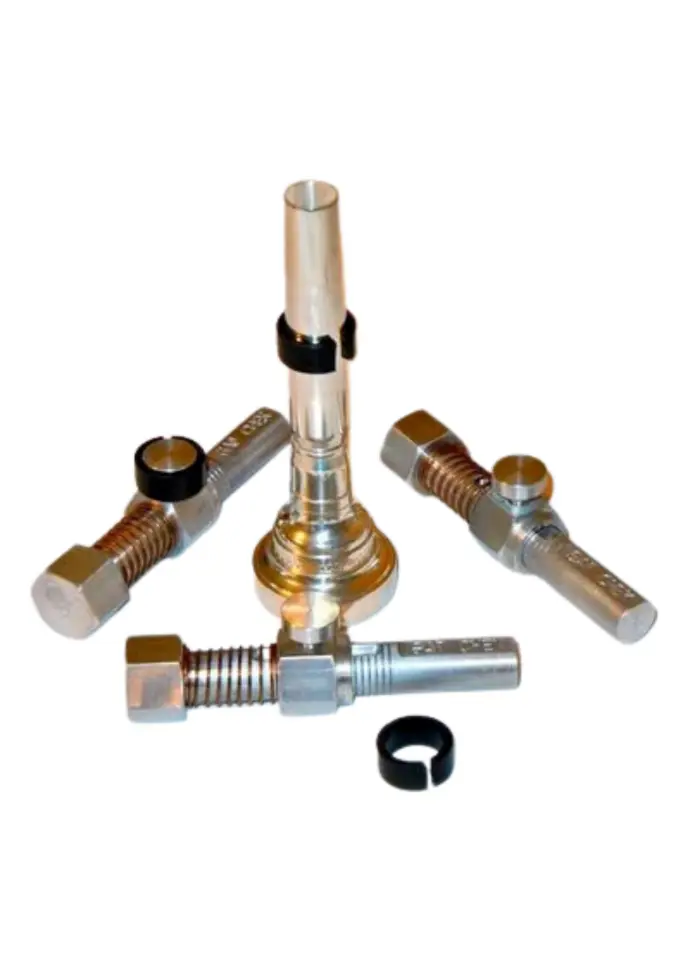Warburton Gap Chek
Tags :
Invented by Ken Titmus, this handy little tool measures the distance between the end of your mouthpiece shank and the beginning of the lead pipe in your trumpet receiver - known as the "GAP".
Did you ever wonder why a given mouthpiece works well in one trumpet, but not very well in another? Often times this problem can be traced to the GAP being too large or small.
In a perfect world, all trumpet manufacturers would get the sizing of the mouthpiece receiver and the position where the lead pipe is soldered into the receiver exactly the same - and trumpet mouthpiece receivers would never wear - and mouthpiece shanks would all be exactly the same size taper. In reality, these perfect conditions don't exist - which in turn results in variations in the amount of GAP.
To complicate things a little more, there is no single "correct" GAP size. The amount of GAP can and will vary between great playing mouthpiece/trumpet combinations.
Too little or too much GAP causes playability problems which can be very difficult to overcome.
If you own multiple horns and/or mouthpieces, you should also own a GAP CHEK.
GAP too large:
- Lower register becomes stuffy
- Upper register may reach a "wall", above which resistance can not be overcome
GAP too small:
- Lower register very free-blowing
- Poor definition to the notes above high C
- Lack of healthy resistance causes upper register to "airball", or wash out
- There is nothing to "lean on" when coming back down from a high passage
What SHOULD the GAP be?
- GAP CHEK has reference lines inscribed every 0.050 inches (fifty-thousandths of an inch).
- Our experience shows that the "sweet spot" for the GAP is usually somewhere between 0.100 and 0.150 inches (between 2 and 3 lines). Of course there ARE exceptions to this.
- If your horn/mouthpiece plays well AND the GAP is within the typical "sweet spot" range of 0.100 to 0.150, then you probably will NOT gain anything by altering the GAP.
- If you are having any of the playability problems described above, then you MAY be able to improve or eliminate the issues by altering the GAP, especially if the GAP is outside the typical "sweet spot" range.
- If your measured GAP is more than 4 or less than 2 reference lines AND you think your horn plays OK, you still MAY find some improvement by altering the GAP to be within the typical "sweet spot" range.
There are several ways to correct GAP problems:
- Use a different size mouthpiece shank. We offer oversized and undersized mouthpiece backbores to help with this. Learn more at our FAQ page about this.
- If you use a one-piece mouthpiece, try a different one - or switch to the Warburton two-piece system which gives you the ability to try larger or smaller sizes.
- Replace your worn trumpet mouthpiece receiver. Usually not a desirable option because the soldering process requires refinishing the trumpet - plus the risk of introducing new problems by altering the trumpet itself.
How does the GAP CHEK work?
Step 1:
- Place the black plastic ring a half inch or so onto your mouthpiece shank

Step 2:
- Insert the mouthpiece into the trumpet receiver as you normally would.
- This will push the plastic ring up the shank to the exact location needed for measurement.
- Set the mouthpiece aside, being careful not to move the plastic ring from its measured position.

Step 3:
- Loosen the thumbscrew on the GAP CHEK just enough for the spring loaded collar to slide freely on the GAP CHEK shaft.
- Then gently push the GAP CHEK into the trumpet receiver until you feel it bottom out against the lead pipe.
- While still holding it against the lead pipe, gently tighten the thumbscrew to lock the sliding collar in position.

Step 4:
- Hold the GAP CHEK next to the mouthpiece with the end against the black plastic ring (being careful not to move the plastic ring from its measured position) and observe the distance between the end of the mouthpiece shank and the sliding collar on the GAP CHEK. This distance is the "GAP".

| Instrument | Trombone or Trumpet |
| Brand | Warburton |




